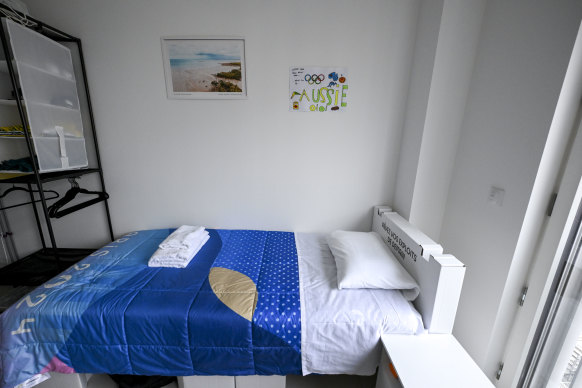Why the beds in Paris could cost athletes their Olympic dream
By Sarah Berry
“Dream about your achievements of tomorrow” may be the inspirational phrase written on the Olympic athletes’ cardboard bedheads in Paris. But, whether the athletes can get to sleep so they can dream is another question.
Australian water polo player Tilly Kearns described the beds as “rock-hard”, and several athletes are already complaining of back pain as a result of sleeping on them.

The village’s cardboard beds have prompted much debate.Credit: Eddie Jim
The infamous cardboard beds were first introduced at the Tokyo Olympics. There was speculation they were designed to deter sex because of the “intimacy ban” at the 2020 Games and because the cardboard may fall apart with sudden movements or extra weight.
The organisers denied this, insisting the sustainable, fully recyclable beds are designed to be environmentally friendly. Still, even with the 300,000 condoms supplied to the Paris village, the beds may be so uncomfortable that they have the effect of being anti-sex.
The manufacturer of the bed, Airweave, states that, along with being sustainable, they are also ergonomic.
“Airweave differs from traditional mattresses by containing no springs or foam,” an Airweave spokesperson told TODAY.com. “We’ve collaborated with sleep experts and athletes to optimise the performance-enhancing benefits of sleeping on an Airweave mattress.
“Not only are Airweave mattresses unique because they’re fully customisable, the science-backed interwoven design also ensures a firmer sleeping surface that maintains ideal sleeping posture, effortless turning, better distribution of weight, and optimal breathability for longer periods of quality sleep.”
Dr Joshua Zadro, of the University of Sydney Institute of Musculoskeletal Health, says ergonomics “has been debunked over the years”.
Research indicates that there is not “one best posture or one best sleeping position” when it comes to mattresses, Zadro says.
He adds that there is some low-quality evidence that firmer mattresses are better at preventing and relieving pain. Still, firm is not the same as “rock-hard” and, given we all sleep in different positions and have different preferences, individual comfort ultimately matters the most.
The effect of an uncomfortable mattress and, in turn, poor quality sleep can be the difference between an athlete achieving their Olympic dreams or going home tired and with a sore back, but without a medal.
From a “performance-enhancing” perspective, the best bed is the one that an athlete can actually sleep in.
“There is a lot of data to show that if you disrupt people’s sleep, or they’re getting poor sleep quality for a prolonged period of time, that can impact performance,” Zadro says.
When a performance difference of 1 per cent or less is what separates those who get medals from those who don’t, the power of good rest is significant.
“At the Olympic level, any sleep disturbance that affects performance would be important,” says Zadro. “Certain sports are more sensitive to sleep deprivation.”
The sports that seem most affected by poor-quality sleep are those requiring speed, tactical strategy or technical skill – which is most sports at the Olympics. Research suggests chronic poor sleep affects reaction times, perceived effort, speed, power, focus and the psychological wellbeing needed to perform at the highest level.
“Sleep is critical to maintaining optimal health [and] plays a key role in recovery,” says Professor Steve Milanese of the School of Health Sciences at the University of Tasmania. “And the mattress is a huge part of that … but the idea you can find one mattress to suit everybody doesn’t exist.”
With such high stakes and athletes looking down the barrel of three weeks of cardboard beds, many have opted for extra pillows and thick mattress toppers (which come packaged in plastic, presumably offsetting at least some of the beds’ environmental friendliness).
They already feel “so much better”, says Kearns on TikTok.
“I am so grateful. I was waking up every second hour. I actually thought about going on the floor ... You’ll be expecting some gold medal performances from here on out from team Australia. Let’s go.”
Airweave was contacted for comment.
Make the most of your health, relationships, fitness and nutrition with our Live Well newsletter. Get it in your inbox every Monday.